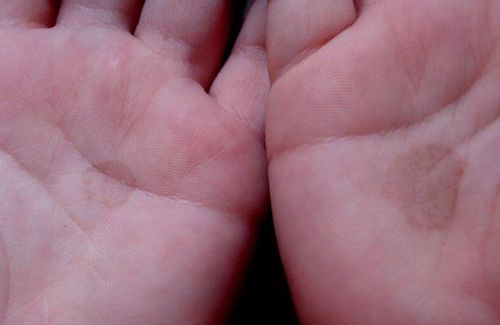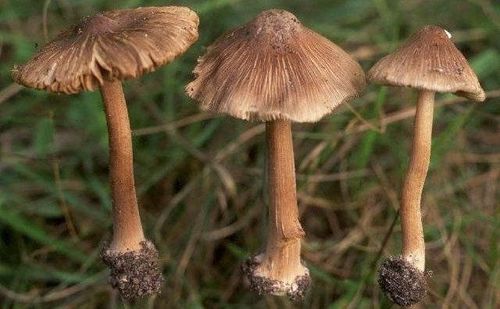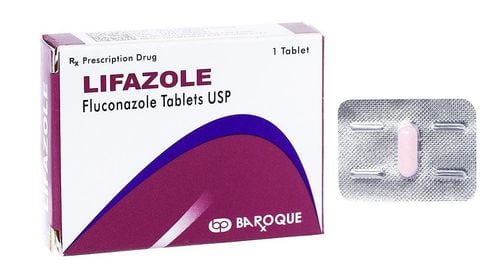This is an automatically translated article.
The hot and humid climate in our country is favorable conditions for wild mushrooms to thrive. Wild mushrooms often grow in the northern mountainous provinces and the Central Highlands. In Vietnam, thousands of species of fungi have been discovered, including hundreds of species carrying toxins.
1. It is difficult to recognize poisonous mushrooms by eye
In fact, among thousands of forest mushrooms growing in the ecosystem of our country, it is not easy to distinguish by eye the poisonous and non-poisonous species.
With agricultural practices, it is easy for people to go to the fields and go to the forest to come across forest mushrooms, only based on the experience passed down from many generations ago that distinguishes which forest mushrooms are non-toxic and harvested. food.
Therefore, every year in our country there are frequent cases of forest mushroom poisoning due to the subjectivity of the people.
More specifically, since 2017, the National Institute of Food Safety and Hygiene has received dozens of forest mushroom poisoning cases, in the first quarter of 2020 alone, 3 cases have been received, of which 10 people were infected. poison, but 5 out of 10 people died.
2. Method of determining toxic substances in mushrooms
To identify a fungus from which to determine whether it is poisonous or non-toxic, researchers need to rely on the external morphological features of the mushroom, the gross color and shape of the fungal spores below. microscopy to classify fungal species.
However, the identification of fungi by morphology requires the researcher to be experienced and have worked for many years in the field of mushroom identification by morphology.
In fact, morphological identification of fungi requires the integrity of the fungus, but mushroom samples obtained from wild mushroom poisonings are sometimes not intact.
Most of the cases of forest mushroom poisoning, the mushroom samples brought to the research institute are just uncooked pieces of mushrooms, or dishes from mushrooms that have been processed and left over, or vomit from the sick stomach. This causes a considerable obstacle in the identification of fungi based on morphology alone.
In recent years, along with morphological methods, molecular biology techniques are also being used to support the identification of toxic fungi. This method uses the ITS fragment located on the ribosomal gene region, the ITS fragment sequence will be amplified by PCR technique. Then sequence and compare new standard sequences on international gene data banks and use Blast tool to identify fungi.
Currently, the database of the international gene database on ITS sequences of poisonous mushrooms is quite complete, which contributes to the identification of wild mushrooms more accurately and conveniently. a lot before.
The National Institute of Food Safety and Hygiene is currently combining both morphological methods and ITS fragment sequencing to analyze and identify forest mushroom samples accurately to the species level, thereby identifying toxic in mushrooms.
MORE: Treatment of toxic mushroom poisoning
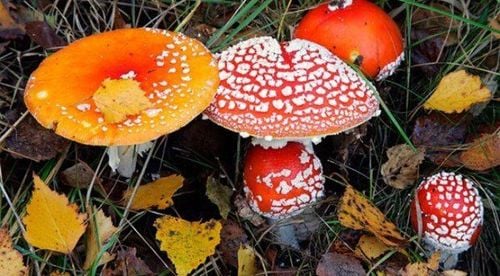
Một số loại độc chất trong nấm rừng gây ngộ độc ở nước ta
3. Some toxins in wild mushrooms cause poisoning in our country
3.1. Toxic Amatoxin
Amatoxin-containing mushrooms (white canopy mushroom, white cone mushroom) often grow in clusters or grow singly on the ground in the forest. This mushroom has a pure white color, the surface of the mushroom cap is smooth, when young, the head is round and ovate in shape and adheres tightly to the stem, when the mushroom is mature, the cap becomes flatter with a diameter of about 5-10cm. for white crowns) or meniscus cones with a diameter of 4-10cm (for cones).
The mushroom blade (underside of the mushroom cap) is white, the stem is also white, the base of the mushroom stalk is enlarged in the form of a tuber and has a base cover like a calyx. The flesh of poisonous mushrooms containing Amatoxin is usually soft, white, with a pleasant aroma (for white canopy mushrooms) or an unpleasant odor (for poisonous cones).
The fungi described above have the main toxins are Amatoxins (also known as Amanitin), this is a highly toxic toxin that directly affects the cytoplasm of cells, leading to cell destruction, especially especially hepatocytes causing acute liver failure.
Symptoms of Amatoxin poisoning usually appear quite late (from 6 to 24 hours after eating mushrooms), toxic manifestations such as abdominal pain, vomiting, diarrhea, jaundice, hemorrhage, little urine or coma. ..The treatment of Amatoxin poisoning should be carried out as soon as possible to minimize the risk of death for the patient.
These mushrooms often grow wild in forests and streams in spring and summer, grow a lot when it rains and are difficult to distinguish from non-toxic mushrooms. On the other hand, because the symptoms of poisoning always appear slowly, the patient comes to the hospital very late, usually after 58 hours, he is brought to the hospital in a very serious condition, with hepatitis, very severe liver failure.
In this case, the most aggressive treatment regimen is usually applied, the treatment cost can be up to 1.6 billion VND, but many patients still die. For Amatoxin poisoning alone, the mortality rate is about 50% or even higher.
SEE ALSO: Poisonous mushrooms: How to recognize?
3.2. Toxic Muscarin
Poisonous mushrooms containing muscarin (gray-brown cap mushroom - scientific name is Inocybe fastigiata or Inocybe rimosa) often grow on the ground in forests or in places with many rotting leaves.
Gray-brown cap mushrooms have conical or bell-shaped caps, pointed tops, and yellow-brown filaments radiating from the top of the mushroom to the edge of the cap. When old, the cap edge of the cap is split into separate rays (gray-brown slits), the diameter of the cap is 2-8 cm. The young mushroom blade is slightly white, firmly attached to the stem, when the old mushroom is gray or brown and separates from the stem. Mushroom stalks are white to yellow-brown, 3-9cm long. Mushroom legs are not bulbous, no stalk ring. Mushroom flesh is white. The toxin in the mushroom is muscarin, which acts on the parasympathetic nervous system, leading to symptoms such as sweating, shortness of breath, stridor, slow pulse, May lead to coma and convulsions. Symptoms of muscarin poisoning appear early (15 minutes - several hours after the fungus), recover after 1-2 days and rarely lead to death.
3.3. Toxins cause digestive disorders
Poisonous mushrooms containing toxins that cause digestive disorders (such as green-bladed umbrella mushrooms) often grow in clusters or singly at the edge of buffalo stables, cow sheds, lawns, corn fields...
Mushroom caps When young, it is long, hemispherical, pale yellow, with small light brown or light gray scales, when mature, the mushroom cap is umbrella-shaped or flat, white, 5-15cm in diameter. The surface of the mushroom cap has thin dirty brown scales, these scales often thicken towards the top of the cap.
Mushroom blade when young is white, when mature it has a light green or grayish green color, the older the mushroom, the clearer the green color. The peduncle of the mushroom is white, the green plate is white to brown or gray in color, has a ring at the upper part close to the mushroom cap, the base of the mushroom stalk is not bulbous and has no root capsule, the stem is 10-30cm long, fleshy. mushrooms are white.
Green-bladed umbrella mushroom is a poisonous mushroom that belongs to the group of toxins that stimulate the gastrointestinal tract - intestines, for a quick effect causing nausea, vomiting, abdominal pain, cramps and diarrhea 20 minutes after eating. - 4 hours, symptoms of poisoning will gradually decrease for up to 2-3 days.
SEE ALSO: Toxic brown gray cap mushroom
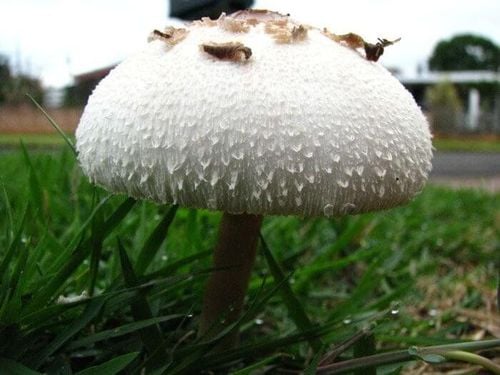
Nấm độc chứa độc tố gây rối loạn tiêu hóa
3.4. Toxins psilocybin and psilocin
Psychedelic mushrooms, also known as Psilocybe mushrooms (Psilocybe pelliculosa), this fungus often grows in places where there is cow dung, rotten grass or rotten wood. Mushroom caps are 1-2 cm in diameter, yellow-brown (when dry, they will change to straw color), mushroom caps are cone-shaped, covered with a clear mucus layer. The mushroom blade is white when young, light green or grayish green when mature, the older the mushroom, the clearer the green color. The peduncle is very long, quite fragile, has the color of the mushroom cap or sometimes turns green or blue. Mushroom flesh is light brown in color, mild in odor and pale in taste.
The main toxins of Psilocybe mushrooms are psilocybin and psilocin, these substances cause mental disorders (causing hallucinations, emotional disturbances, excitability), symptoms of poisoning usually appear soon (1 hour after eating). and usually resolves within 12-24 hours.
4. Mistakes when distinguishing poisonous mushrooms
The concept of poisonous mushrooms is colorful mushrooms, but in fact, the most poisonous mushrooms that can be deadly are white, have a benign appearance, look like normal mushrooms, and when eaten, they have taste very good. Mushrooms eaten by insects are non-toxic mushrooms, practically all poisonous mushrooms can be eaten by ants, snails, and insects (mycotoxins do not work against insects, worms, ants, snails) . Bring mushrooms to animals (chickens, dogs...) to eat first, if the animals eat mushrooms okay, this is a non-toxic mushroom. However animals are very different from humans (this is true only for certain fungi and certain animals, while many animals are not sensitive to amatoxins), animal testing is impractical because it takes several days to monitor (if it is amatoxin, animals usually die on days 5-7 after eating mushrooms). Try to poison mushrooms with spoons, necklaces, rings... in silver, if silver changes color to dark gray, it is poisonous mushrooms, this is completely wrong because mycotoxins will not work on silver, so it will no discoloration. In short, when facing a wild mushroom, we must not pick it up or eat it or take time to distinguish between poisonous and non-toxic mushrooms due to the very high risk of confusion.
Please dial HOTLINE for more information or register for an appointment HERE. Download MyVinmec app to make appointments faster and to manage your bookings easily.







